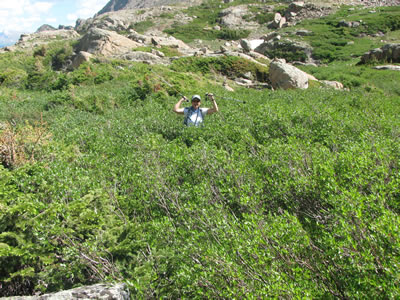| 265 | Guidebooks | 2010-08-09 |

Amy lost in a sea of willows, following me!
On cloudhiking, we write online guides of various trails. We therefore are interested in comments about ours and others guides.
Recently 14ers had a thread added to the Forum which suggested the guide was wrong. The writer had tried to climb Mount Quandry and basically felt it was harder than a Class 1 (a trail), there was snow on the trail, and the route was hard to follow. The visual guide (14ers.com), the thread author claimed, did not accurately describe the route. The community of 14er users took offense to the comments.
The topic was finally locked. Enough.
When hikers are having a bad day, it is common to blame someone rather than admitting fault. We often have bad days in the mountains. In fact it is odd when we both feel strong at the same time. The guide we are using has little to do with the fact that we ate too much or ate the wrong foods before the climb.
The guide is merely a direction. "Follow the East Ridge to the summit," is a guide. It gets you to the top; but it falls short of being an inch by inch account of the route to the summit. A fine line exists between too much data and not enough. Almost every hiker would probably disagree just how much should be included. The amount of route direction needed decreases as the participants skill level increases. Rookies need a comprehensive play book whereas pros can just wing it. It is okay to suggest that more information might be needed or that the trail has changed. But, it is also interesting to note that with more experience the same hiker might be happy with the guide even if it only contains scanty information.
A few using a guide book (or online guide) suggestions...
- Look for more than one resource. Each guide offers different facts on the same trail. If they all said the same thing, there would only be one.
- Compare the guide to the map. Mark on the map.
- Download GPS data. Does the data agree with the map and guide?
- Never lead a group on a trail where you have not personally gone. The best guide is personal experience. Hike the trail prior to leading a group. There are no shortcuts to being a good leader.
- Do not blindly follow a guide. The guide may be wrong, the trail may have been altered since the guide was written, or the guide might be right - but the trail is wrong.
Remember: the guide is only a guide, you decide where to go and where and when to turn around. Hopefully, at the summit!
Happy guidebook trails.